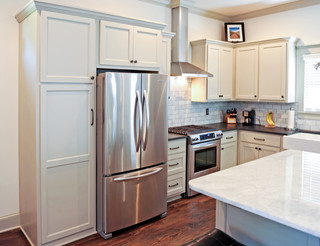
The front edge of these types is usually wrapped around by three-quarters of an inch to one inch for more protection against moisture damage due to spills from cooking activities. A standard overlay has two pieces that fit together nicely at the corners with no gaps between them, which means they can be installed without any butt joints (they overlap each other). They have a reveal of one inch to three-quarters of an inch, depending on the size and style of cabinetry in question. This type of cabinet often has an overlay on top to cover up unfinished edges and provide some visual interest for your kitchen space. This design allows for more storage space as it covers up what would otherwise be wasted space between cabinets and offers an overall cleaner appearance. The standard overlay is the most commonly found kitchen cabinets with doors covering the entire front surface.
#Overlay cabinets vs partial full#
But what about the difference between standard and full overlay cabinets? Standard Overlay Cabinets This includes choosing from a variety of door styles and finishes. There are many ways to improve the look of your kitchen, but one of the most popular is by revamping your cabinet doors. In this blog post, we’ll discuss the difference between standard and full overlay kitchen cabinets- what they are, how they work, and who needs them! What are standard cabinets, and what are full overlay cabinets? Kitchen designers will have their opinions, but there is no one size fits all answer. If you are in the market for new kitchen cabinets, it can be challenging to decide which type of cabinet is best for your space. That’s why it’s essential to know what kitchen cabinets you’re going to install. Kitchen cabinetry can be one of the most expensive parts of a kitchen remodel or renovation. They provide a unique style and personality to space, as well as storage for your dishes, pots and pans, and other food items. Most notably, due to the exposed frame, or gap, hardwood is not needed for these cabinets.Cabinets are an essential part of any kitchen. This type of cabinetry is the most popular and most budget-friendly. Partial overlay cabinetry exposes the cabinetry frame, leaving a gap in between the doors and drawers. This cabinetry style requires hardware to be adhered, as well. Unlike with inset cabinetry where the cabinet frame is fully visible, full overlay cabinetry frames are completely concealed, along with their hinges. The doors (and drawers) of these cabinets have extra-large fronts that sit on top of the frame. Full overlay cabinets provide a similar appearance to inset cabinets at a fraction of the cost. Overlay Cabinetry – There are two types of overlay cabinetry: full overlay and partial overlay. Humidity can also affect this type of cabinet making it difficult to close or for rubbing to occur with wood expansion. However, inset cabinetry comes at a cost as they require more labor to create.


Inset cabinetry appeals to homeowners for its smooth, clean finish and craftsmanship overall. Additionally, the hinges of the doors can be either exposed or hidden. However, due to the door being set within the frame, pulls and/or knobs will be needed for this cabinetry type.

This means that when the door is closed, it will align with the frame, rather than rest on top of it. Inset Cabinetry – Inset cabinetry is built to fit within the cabinet’s frame, creating a flush appearance. Confused? Don’t worry! Most homeowners are unaware of what this means. However, one aspect of cabinetry that is often overlooked-and even sometimes unknown to homeowners-is the choice between inset or overlay cabinetry. From color to style, to varying materials, there are more than a few options to choose from when selecting which is best for your home. Let’s talk cabinets, shall we? We can all agree that there are hundreds, if not thousands, of different types of cabinets on the market.


 0 kommentar(er)
0 kommentar(er)
